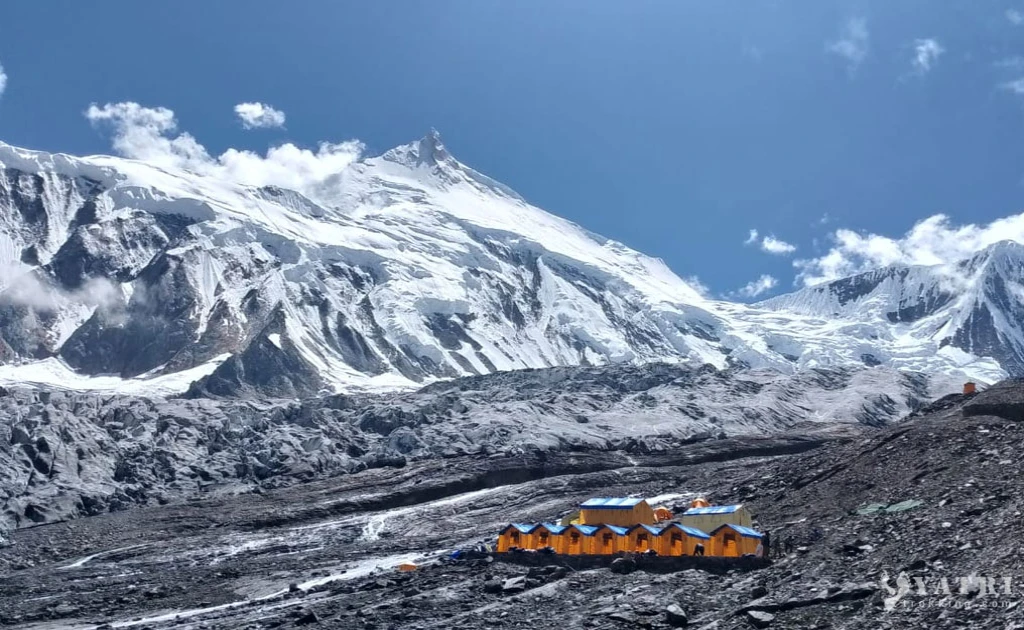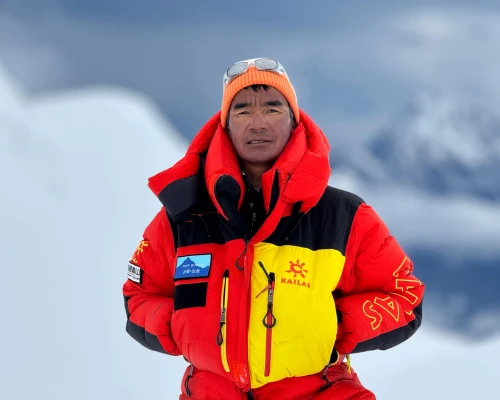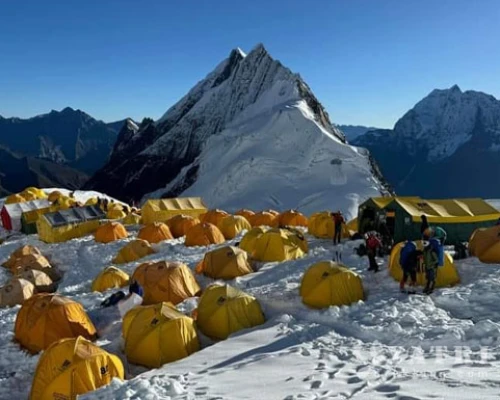Preparation for Manaslu Expedition
Climbing an 8,000-meter peak like Manaslu (8,163m) is a major undertaking that requires physical endurance, mental resilience, and technical skills. Adequate preparation is not optional—it’s essential for your safety and success.
🧠 Mental & Physical Preparation
You should start preparing at least 4–6 months before the expedition. Regular cardiovascular exercises, altitude training, and strength conditioning should be part of your routine. Focus on:
Running, cycling, or swimming for cardiovascular fitness
Hill walking or stair training with a weighted backpack
Strength training (especially legs and core)
Yoga or breathing exercises to improve oxygen efficiency
🧗♂️ Climbing & Technical Skills
While Manaslu is considered one of the more accessible 8000ers, it still involves technical sections with fixed ropes, crevasse zones, and steep ice slopes. You should be familiar with:
Using a jumar (ascender) and figure-8 descender
Walking on fixed ropes and ladders
Self-arrest techniques with an ice axe
Putting on crampons and harnesses efficiently
Climbers with previous experience on 6000m+ peaks like Island Peak, Lobuche East, or Mera Peak will be better prepared.
🌍 Altitude Acclimatization
To avoid Altitude Mountain Sickness (AMS), our itinerary includes multiple acclimatization rotations and rest days. However, if possible, consider joining a pre-expedition trek like:
These treks help your body adjust to elevation and test your gear before the main expedition.
📝 Documentation & Permits
Make sure your passport is valid for at least 6 months, and inform us of any medical conditions or dietary restrictions early. We will handle the Manaslu climbing permit, special restricted area permit, TIMS card, and liaison officer arrangements.
Being well-prepared means you're not just physically ready, but also mentally confident and logistically sorted for your summit push.
Best Season or Time for Manaslu Expedition
Choosing the right season is essential for a safe and successful Manaslu Expedition. The two best climbing windows are pre-monsoon (spring) and post-monsoon (autumn), which offer stable weather, lower avalanche risk, and clearer summit views.
🌸 Spring Season (April to Early June)
Spring is one of the most popular times to climb Manaslu. The weather is relatively stable, and temperatures begin to rise after the winter freeze.
Pros:
Fresh snow and better snow-ice conditions on the mountain
Less crowded trails and climbing routes
Warmer base camp and high camp temperatures
Ideal for photography: wildflowers and green valleys
Cons:
👉 Recommended for: Climbers who want a slightly warmer expedition and are used to navigating fresh snow conditions.
🍂 Autumn Season (Mid-September to Late October)
Autumn is the best time to climb Manaslu due to its clear skies and dry weather following the summer monsoon.
Pros:
Stable weather and lower wind speeds
Excellent visibility for summit views
Dry, well-defined trails during the approach trek
Popular among climbers, so shared logistics are easier
Cons:
👉 Recommended for: First-time 8000m climbers or those seeking ideal summit windows with high visibility.
⚠️ Avoid Monsoon (June–August) and Winter (December–February) due to high avalanche risk, heavy snowfall, and extreme cold.
Food on Manaslu Expedition
Proper nutrition is crucial for a successful high-altitude expedition, especially when you're pushing your body to extreme limits. During the Manaslu Expedition, you’ll receive carefully planned meals that are high in calories, warm, and hygienically prepared to fuel your climb.
🍽️ Meals During the Trek (Teahouse Phase)
While trekking to base camp, you’ll stay in local teahouses that serve traditional Nepali, Tibetan, and basic Western meals.
Typical options include:
Dal Bhat (rice, lentils, vegetables) – unlimited refills!
Noodles, pasta, or fried rice
Chapati with curry or eggs
Tibetan bread, pancakes, porridge
Boiled eggs, tea, coffee, and seasonal fruits
We recommend eating hot meals and drinking boiled or purified water to avoid stomach issues.
🏕️ Meals at Base Camp and Above
Once we reach Manaslu Base Camp (4,800m), our professional cook team will take over meal preparation.
Base Camp Menu Highlights:
Energy-rich breakfasts: oats, porridge, eggs, muesli
Lunch/dinner: rice, pasta, lentils, vegetables, chicken
Snacks: popcorn, cookies, boiled potatoes, hot soup
Warm drinks: herbal tea, black tea, coffee, hot lemon
All food is cooked in a clean and sanitized kitchen tent using gas stoves and filtered water.
🧗♂️ High Camp Meals (Camp I, II, III)
At higher altitudes, meals become simpler but still calorie-focused. Sherpas will help prepare freeze-dried or instant meals, and you'll be given high-altitude snacks like:
Energy bars, chocolate, and dried fruits
Instant noodles and soup
Powdered drinks (Tang, electrolytes, tea bags)
High-carb mountaineering food packs
⚠️ If you have dietary restrictions (vegetarian, gluten-free, etc.), let us know in advance—we’ll adjust the menu to meet your needs.
💡 Tip for Clients:
Bring a few of your favorite energy gels, bars, or electrolyte packets from home—your body will thank you on summit day!
Accommodation During Manaslu Expedition
During the Manaslu Expedition, your accommodation will vary depending on the phase of the journey—from comfortable hotels in Kathmandu to teahouses on the trekking route and high-altitude tents during the climb. We ensure that every stay is clean, safe, and suited for climbers preparing for an 8,000-meter challenge.
🏨 In Kathmandu (Pre & Post Expedition)
Before and after your expedition, you’ll stay in a 3-star or equivalent hotel in Thamel, the heart of Kathmandu’s tourist district. These hotels offer:
Private rooms with attached bathrooms
Free Wi-Fi
Breakfast included (Bed & Breakfast plan)
Hot showers and luggage storage
Easy access to gear shops and restaurants
🛏️ On the Trek to Base Camp (Teahouse Lodging)
During the 7–9 days it takes to reach Manaslu Base Camp, you'll stay in traditional local teahouses run by friendly mountain families.
Teahouse facilities include:
Twin-sharing or private rooms (simple, wooden beds)
Communal dining area with fireplace
Shared bathrooms (mostly squat toilets)
Basic blankets (but bring your sleeping bag)
Electricity or solar charging (small fee may apply)
📝 These teahouses are modest but cozy, offering an authentic trekking experience in the Himalayas.
🏕️ At Base Camp (4,800m)
Once at base camp, we switch to a fully managed tented camp system. You’ll have your own tent and access to dedicated staff support.
Base Camp Setup Includes:
High-quality expedition tents (single or twin sharing)
Dining tent with tables and chairs
Kitchen tent with staff preparing fresh meals
Toilet tent with biodegradable sanitation
Solar charging and satellite communication
⛺ At High Camps (Camp I, II, III)
Above base camp, we use lightweight alpine tents designed for extreme weather. These are shared by 2 climbers per tent and are set up by our Sherpa team in advance.
Note: There are no permanent structures at high camps—this is true mountaineering. Sleeping bags rated to -40°C are a must, and we provide insulated mats for added warmth.
Your comfort and rest are key to summit success. Whether it’s a hot tea at a teahouse or a peaceful rest at 6,800m, we ensure the best possible accommodation throughout the expedition.
Manaslu Expedition Difficulty
The Manaslu Expedition is considered one of the more accessible 8,000-meter peaks, yet it remains a serious and physically demanding climb. It requires a high level of fitness, prior high-altitude experience, and technical climbing skills. This is not a beginner-level expedition.
🧗♀️ Technical Challenges
The route involves steep snow slopes, icy ridges, and occasional crevasse crossings. Fixed ropes are used in steep and exposed sections, especially between Camp I and Camp III. Some areas may require use of ascenders, crampons, and ice axes. While not as technical as K2 or Kangchenjunga, it’s more complex than trekking peaks like Mera or Island Peak.
💪 Who Is This Climb For?
Manaslu is best suited for climbers who have already completed at least one 6,000–7,000m Himalayan peak and are familiar with:
Using fixed ropes and jumars
Glacier travel and crevasse navigation
Climbing with heavy boots and crampons
Coping with extreme altitude and cold
❄️ Key Difficulty Factors (Bullet Summary)
🧱 Altitude: Climbing above 8,000m is physically and mentally exhausting.
🧗 Steep Terrain: Ice walls, knife-edge ridges, and soft snow in sections.
🌬️ Weather: Sudden storms and wind gusts over 80 km/h can delay summit pushes.
🏕️ Limited Rescue: Above Camp III, self-rescue or Sherpa assistance is essential.
🕒 Long Hours: Summit day can last 12–16 hours round trip from Camp III.
⚠️ Not Recommended For:
✅ Training Tip: Simulate expedition fatigue by doing long hikes with a weighted pack, followed by strength sessions or stair climbs. Practice glacier travel and rope systems in advance.
Travel Insurance for Manaslu Expedition
Having comprehensive travel insurance is a mandatory requirement for the Manaslu Expedition. Climbing an 8,000-meter peak carries inherent risks, including altitude sickness, injuries, flight cancellations, and even emergency helicopter evacuations. Without proper insurance, rescue costs alone can reach $5,000–$10,000 or more in Nepal.
🛡️ What Your Insurance Must Cover:
🚁 Emergency helicopter evacuation (up to 6,000m or higher)
⛰️ High-altitude trekking and climbing (up to 8,200m or more)
🏥 Medical expenses in Nepal and repatriation to home country
📅 Trip interruption, delay, or cancellation due to weather or illness
💼 Loss or damage to baggage, gear, or documents
✅ Recommended Insurance Providers for High Altitude Climbers:
Global Rescue – excellent for evacuation and rescue services
World Nomads – customizable for adventure sports (check altitude limit)
Ripcord Rescue Travel Insurance – trusted by mountaineers
True Traveller (EU/UK residents) – offers high-altitude sports packages
International SOS – premium coverage for expeditions and NGOs
⚠️ Always check the maximum altitude limit covered (should be at least 8,200m), and ensure climbing with ropes is not excluded.
🔍 Tip for Clients:
Email your insurance provider a copy of your Manaslu itinerary and expedition details, so you get confirmation in writing that your policy will cover the climb.
🔐 Required Documentation:
Before departure, we require:
Copy of your insurance policy certificate
Emergency contact details
Policy number and hotline information
Altitude Sickness Risk in Manaslu Expedition
Altitude sickness, also known as Acute Mountain Sickness (AMS), is a real concern during the Manaslu Expedition, especially above 3,000 meters and particularly at high camps above 6,000 meters. Because Manaslu reaches 8,163m, climbers are at risk of more severe forms like HAPE (High Altitude Pulmonary Edema) and HACE (High Altitude Cerebral Edema) if proper precautions are not followed.
⚠️ Common Symptoms of AMS:
If symptoms worsen instead of improving with rest, descent becomes essential.
🧠 Severe Altitude Illness Warning Signs:
Confusion or difficulty walking (possible HACE)
Persistent dry cough, chest tightness (possible HAPE)
Blueness of lips or nails
Fast heart rate even at rest
✅ How We Minimize Altitude Sickness Risk:
At Yatri Trekking, safety is our top priority. We follow strict acclimatization protocols and provide medical support throughout the expedition.
Prevention Measures Include:
📅 Gradual ascent with built-in rest and acclimatization days
🏕️ Rotation climbs between camps to adapt slowly
💊 Use of Diamox (acetazolamide) when recommended
💉 Oxygen bottles and masks available at high camps
🩺 Daily oxygen saturation and pulse checks at base camp
🧭 Trained guides to identify and respond to symptoms early
🚁 Helicopter evacuation arranged in case of emergency
💬 Advice for Climbers:
Stay hydrated (4+ liters/day)
Avoid alcohol and sleeping pills at altitude
Report symptoms to your guide immediately
Don’t rush—climb high, sleep low
🚨 Remember: AMS can affect anyone, regardless of age or fitness level. Listening to your body and your guide is key.
Manaslu Expedition Guide and Safety
When you’re climbing an 8,000-meter peak like Manaslu, your guide is not just a companion — they are your lifeline. At Yatri Trekking, we prioritize safety, experience, and local expertise by employing certified IFMGA and NNMGA mountain guides who have summited Manaslu multiple times.
🧭 Why a Professional Guide is Essential:
🧗♂️ Leads fixed rope setups and ensures anchor safety
📡 Constantly monitors weather, route conditions, and team health
⛑️ Offers first aid and altitude sickness treatment when needed
🧠 Makes crucial decisions in high-risk situations
🔁 Manages rotation climbs for proper acclimatization
Our guides are fluent in English, trained in high-altitude rescue, and maintain communication with base camp at all times.
🚨 Our Safety Protocol Includes:
✅ High guide-to-client ratio for personalized attention
✅ Regular health checks and oxygen saturation monitoring
✅ Backup oxygen bottles, regulators, and masks at Camp III and higher
✅ Satellite phone and radio communication
✅ Emergency helicopter evacuation coordination
✅ Weather forecast updates from Kathmandu HQ
✅ Contingency days in case of weather delays
📚 Our Guides Are Trained In:
👷 All our guides have completed technical climbing training through the Nepal Mountaineering Association and have real experience on multiple 8,000ers.
🧡 Support Team Members:
Experienced base camp cook and kitchen staff
Sherpas or high-altitude porters (HAPs) to carry gear above base camp
Trekking support staff for logistics before and after the summit push
Manaslu Expedition Booking Procedure
Ready to conquer the eighth-highest mountain in the world? Booking your Manaslu Expedition with Yatri Trekking is simple, transparent, and fully supported by our expert team.
Follow these easy steps to secure your adventure:
📋 Step-by-Step Booking Process:
Send an Inquiry
→ Contact us via our official website or email us directly to express your interest and dates.
Customize Your Expedition
→ Discuss your preferences, experience level, and travel plans. We'll help tailor the itinerary and logistics accordingly.
Confirm Availability & Trip Cost
→ We’ll provide you with a final trip cost based on your group size, preferences, and chosen date (see cost table above).
Secure Your Spot
→ Pay a 25% deposit to confirm your place. We’ll send a secure payment link or bank details.
→ You’ll receive a confirmation invoice and trip dossier.
Submit Required Documents
→ Copy of your passport
→ Passport-size photo
→ Previous climbing experience (if available)
→ Travel insurance certificate
→ Flight details
Visa and Flight Support
→ Need help with Nepal visa or flights? We’ll guide you through it all.
Final Payment
→ Remaining balance is due 30 days before the expedition start date.
Arrival in Nepal
→ Our team will welcome you at Kathmandu Airport and handle everything from that point forward.
🔐 Payment & Cancellation Policy:
💳 Secure payment via bank transfer, online gateway, or cash
❌ Free cancellation up to 45 days before departure
🔁 Trip rescheduling available if needed
🎯 We also help with permit processing, gear rental, travel insurance, and airport transfers.







